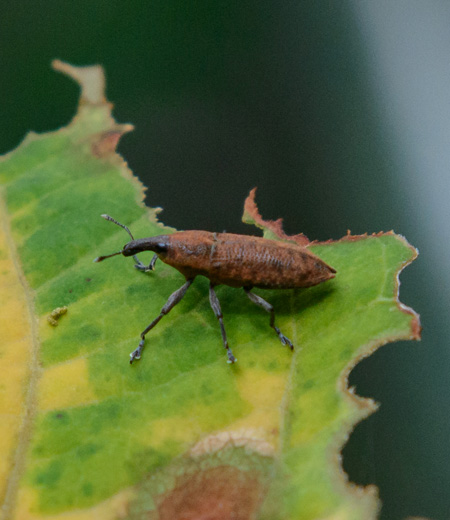Mt. Takao is considered one of the three major habitat of insects along with Minoo (Osaka prefecture) and Kibune (Kyoto prefecture) and it has long been loved by researchers of insects because of number of species and the easy access from the Metropolitan area. There are many insects first found in Mt. Takao and named after "Takao" such as Takao Shachihoko (Hiradonta takaonis Matsumura) and Takao medaka kamikiri (Stenhomalus takaosanus).

Main Region: Hokkaido, Honshu, Shikoku, Kyushu and Tsushima.
Found in woods and green space from flatlands to mountains.
The unique name Katsuo-zoumushi literally meaning bonito curculionidae was named because the body shape is elongated streamline shaped and covered with red-brown powders that resemble dried bonito, katsuo-bushi.
Somehow the word bushi (ship-shape used to be called) was eliminated from the name of this species.
When red-brown powders come off, base color of black appears.
Tips of fore wings are pointed.
Similar lixus acutipennis have v-shaped black patterns on fore wings and have wider tips Feed on leaves of plants in polygonaceae family including fallopia japonica and water pepper often rest on these leaves.
Larvae feed on the center portions of stems of the plants adults feed on.
●Length about 10 to 12 mm
●Adults Flight Season May to about August
Found in woods and green space from flatlands to mountains.
The unique name Katsuo-zoumushi literally meaning bonito curculionidae was named because the body shape is elongated streamline shaped and covered with red-brown powders that resemble dried bonito, katsuo-bushi.
Somehow the word bushi (ship-shape used to be called) was eliminated from the name of this species.
When red-brown powders come off, base color of black appears.
Tips of fore wings are pointed.
Similar lixus acutipennis have v-shaped black patterns on fore wings and have wider tips Feed on leaves of plants in polygonaceae family including fallopia japonica and water pepper often rest on these leaves.
Larvae feed on the center portions of stems of the plants adults feed on.
●Length about 10 to 12 mm
●Adults Flight Season May to about August
